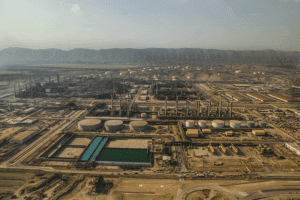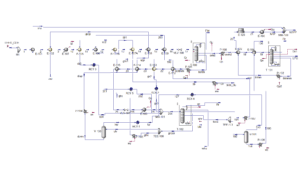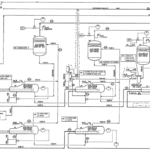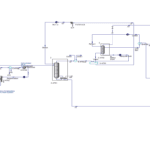Introduction
The STAR Oil Refinery, located 25 kilometers west of Bandar Abbas, is the largest gasoline producer in Iran and the largest gas condensate refinery in the world. Utilizing advanced technologies and relying on domestic capabilities, the refinery has made significant strides toward achieving self-sufficiency in the production of petroleum products, especially gasoline. This project is recognized as one of the largest industrial investments in Iran’s history.
The distillation unit (atmospheric and vacuum) is the first processing unit and one of the most crucial refinery units. It separates the incoming raw feed into various petroleum fractions and consumes more energy than most other refinery units after water and steam units. Typically, the products of the distillation unit are considered mid-range products in the refining industry. In many cases, increasing the quantity or quality of a specific fraction through operational parameters without changing the design and size of various equipment is desired, making an accurate simulation file extremely important.
Once the distillation process is simulated, the created file can serve as a valuable tool for studying and optimizing these processes. By adjusting operational parameters and defining various scenarios to align with desired product specifications, optimal processing conditions can be established to enhance unit profitability. Key performance indicators for the distillation unit, both at the refinery level and for individual units and equipment, as well as general indicators like water, steam, and electricity consumption and the ratio of light to heavy products, are essential and are studied based on ISO 50001 standards. Therefore, we aim to model and simulate this unit for further examination.
STAR Oil Refinery Distillation Unit
This unit is one of the largest and most important oil distillation projects in Iran, situated near Bandar Abbas in the Persian Gulf Special Economic Zone, primarily converting crude oil into high value-added petroleum products.

Characteristics and Specifications of the Unit
1. Production Capacity: This unit is among the largest crude oil distillation units in the Middle East, with a daily processing capacity exceeding 300,000 barrels of crude oil.
2. Produced Products: The unit produces gasoline, diesel, fuel oil, and petrochemical products, playing a crucial role in meeting domestic needs and exports.
3. Advanced Technology: It employs modern and advanced technologies in distillation and oil refining processes, enhancing efficiency and reducing environmental pollutants.
4. Economic Importance: The STAR crude oil distillation unit is key to the development of Iran’s oil and gas industries, potentially reducing the country’s dependence on gasoline and petroleum product imports.
5. Infrastructure Development: Auxiliary projects such as oil transfer facilities, storage systems, and pipelines also enhance overall efficiency.
6. Organization and Management: Managed by the National Iranian Oil Refining and Distribution Company, collaboration with international partners has been established for the supply of necessary equipment and technologies.
Strategic Goals
– Meeting Domestic Needs: One of the key objectives is to supply the domestic market’s fuel and other petroleum product needs.
– Exporting Petroleum Products: With increased production, Iran aims to export high-quality products to international markets, thus bolstering the national economy.
Process Description
The simulation and optimization of the STAR Oil Refinery distillation unit using specialized software like Aspen HYSYS is a scientific and engineering process aimed at enhancing performance and reducing costs. The stages of this unit are described as follows:
1. Preliminary Heating: Gas condensates are pumped to the distillation unit, where temperature and pressure are controlled in heat exchangers, raising the temperature to 194 degrees Celsius before entering the Pre-fractionator Column.
2. Pre-fractionation Column: Gas condensates enter the pre-fractionator, where various components are separated using steam and heat exchangers. This column has 28 trays, with controlled temperature and pressure. The steam output is cooled and sent to a drum to separate salty water from hydrocarbons.
3. Second Pre-heating: The pre-fractionated condensates are heated again to 227 degrees Celsius, utilizing heat exchangers that transfer heat from various products.
4. Main Distillation Column Inlet Heater: The heated condensates are transferred to the heater of the main distillation column, mixing with some lower column products to prevent excessive vaporization.
5. Main Distillation Column: Condensates enter the main column with 47 trays, where vapor and liquid contact creates separation based on boiling points, producing products like heavy naphtha, kerosene, and diesel.
6. Final Products: Final products including heavy naphtha, kerosene, and diesel are directed to subsequent processing units, with some stored in storage tanks.

Simulation and Optimization Process
1. System Modeling: Define process inputs (crude oil type, composition, temperature, pressure) and expected outputs (various products) to create a model in Aspen HYSYS using distillation columns, tanks, pumps, and heat exchangers.
2. Process Simulation: Include all present equipment and processes with their operating parameters (temperature, pressure, flow rates) and establish conditions for reliable modeling.
3. Results Analysis: Use data from the simulation to assess system performance and identify inefficiencies, reviewing energy costs, raw materials, and production for optimization opportunities.
4. Process Optimization: Utilize optimization algorithms in Aspen HYSYS to adjust key parameters (temperature, pressure, flow rate) for maximum output and minimal cost, followed by re-simulation to analyze the overall unit’s performance.
5. Conclusion and Implementation: Final reports compile all simulation and optimization results, presenting suggestions for improvement. Approved changes may be implemented in the actual process.
6. Monitoring and Feedback: Collect operational data post-implementation to evaluate unit performance, contributing to continuous optimization efforts.
Conclusion
The STAR crude oil distillation unit holds significant economic and industrial importance and is regarded as a successful model for developing oil refining processes in the country. This project not only increases refining capacity but also improves quality of life and alleviates fuel supply issues within the country.
Simulating and optimizing the STAR crude oil distillation unit using Aspen HYSYS enables meticulous performance analysis and can lead to innovative approaches for improving efficiency and reducing costs, empowering engineers to make better decisions in designing and managing industrial units.
Simulation and Optimization of STAR Oil Refinery Distillation Unit using Aspen HYSYS
In this project, the simulation and optimization of the STAR crude oil distillation unit have been conducted using Aspen HYSYS version 14.


